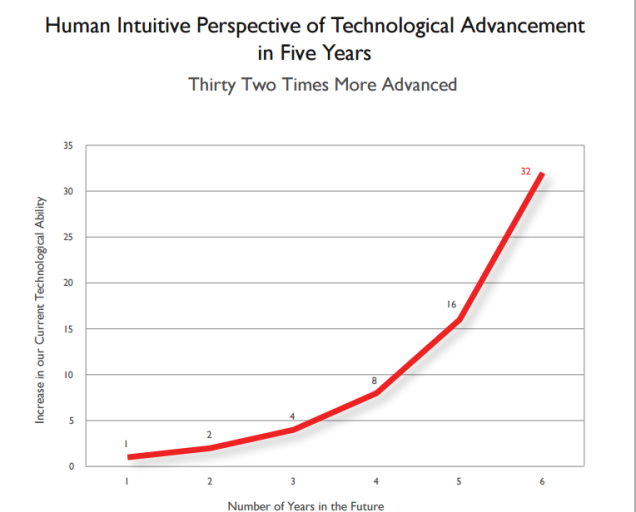Chart and verbiage from The Emerging Future.
“Eighteen to twenty years out, technological advancements will be hundreds of thousands to a million times more advanced. That makes our first 14 years of exponential growth seem flat-lined (no progress), when, in fact, it will be 4,000 times more advanced than today. We currently have regenerative medicine in clinical trials and consumer wireless computer-brain interfaces for $300. What will it be like in 20 years when technology is a million times better?”
Many serious and respected scientist and futurists predict that continuing technological advancements at the current rate will result in a technological singularity.
“The technological singularity is the hypothetical advent of artificial general intelligence (also known as “strong AI”). Such a computer, computer network, or robot would theoretically be capable of recursive self-improvement (redesigning itself), or of designing and building computers or robots better than itself. Repetitions of this cycle would likely result in a runaway effect — an intelligence explosion[1][2] — where smart machines design successive generations of increasingly powerful machines, creating intelligence far exceeding human intellectual capacity and control. Because the capabilities of such a superintelligence may be impossible for a humans to comprehend, the technological singularity is an occurrence beyond which events may become unpredictable, unfavorable, or even unfathomable.”
Scary and as of now at least, hypothetical and movie fodder, however, let’s look out a mere five years:
What will be the impact on education? Technologies have already been created to give us the ability to:
- Regenerate our sick and aging bodies giving us healthy radical longevity
- Personal guidance
- Free energy
- Desktop fabricators
- An interactive intelligent environment
- Accident free autonomous transportation
- Embedded nano and micro intelligent systems in our body and environment
- Advanced cybernetic and bionic senses, organs, and limbs that are superior to our biological ones
- Poverty reduction tools to create worldwide abundance and then radical abundance
- Computer brain interfaces allowing for our intelligence to multiply millions of times
- Manipulate molecules and atoms
- The ability to live in space
And the following technologies are here today: Sensors, nanotechnology medicine, quantum computing, bioinformatics, synthetic biology, robotics, nanobots, artificial organs and senses, ubiquitous knowledge, smart materials, open source software, IBM’s Watson, Google search, Siri, Google assistant, computer-brain interfaces, telepresence robots, self-aware robots,3D printing, longevity escape velocity biotech, server farms (the cloud), microelectromechanical systems, smart phones, tablets, cybernetic limbs, medical tricorders, personal genome, genetic analysis, genomic engineering, proteomics, exoskeletons, autonomous machines (cars, planes, insects, rats, birds, weapons, etc.), gene therapy, desktop sequencers, regenerative medicine (regenerating, growing, and printing human body organs), computer made synthetic life, interactive surfaces, Google’s Project Glass, Google Fiber, augmented reality, cryogenics, repurposed drugs, nanotubes, nano-shells, nanoviricides, and smart, interactive, and energy producing walls, floors, countertops, mirrors, doors, and windows.
What this last graph means is that your eighth-grade student, by the time she graduates from high school will be facing a higher education technological world that is 32 times more advanced than the one she knows today. Exactly how are educators expected to predict and educate students to such a world? And by the time our eighth-grader graduates college and is expected to perform in the real world, she will be in a world of technology that is 500 times more advanced than today’s. How does one prepare a student to compete in a global marketplace that has been so dramatically changed by technology?

